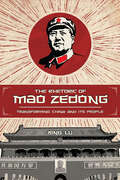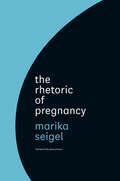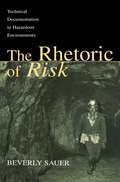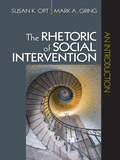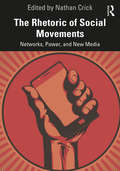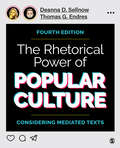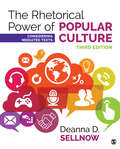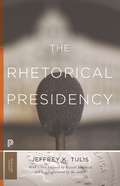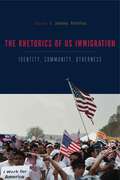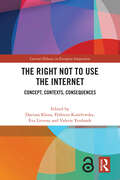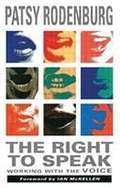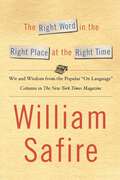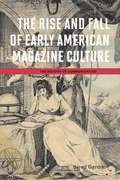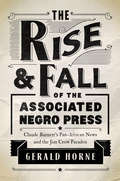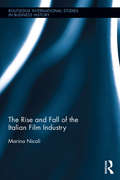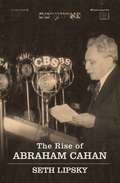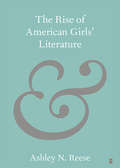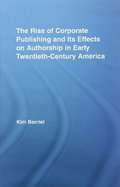- Table View
- List View
The Rhetoric of Judging Well: The Conflicted Legacy of Justice Anthony M. Kennedy (Rhetoric and Democratic Deliberation)
by David A. Frank And Francis J. Mootz IIIKnown as the “swing justice,” Justice Anthony M. Kennedy provided the key vote determining which way the Supreme Court would decide on some of the most controversial cases in US history. Though criticized for his unpredictable rulings, Kennedy also gained a reputation for his opinion writing and, more so, for his legal rhetoric.This book examines Justice Kennedy’s legacy through the lenses of rhetoric, linguistics, and constitutional law. Essays analyze Kennedy’s opinion writing in landmark cases such as Romer v. Evans, Obergefell v. Hodges, and Planned Parenthood v. Casey. Using the Justice’s rhetoric as an entry point into his legal philosophy, this volume reveals Kennedy as a justice with contradictions and blind spots—especially on race, women’s rights, and immigration—but also as a man of empathy deeply committed to American citizenship.A sophisticated assessment of Justice Kennedy’s jurisprudence, this book provides new insight into Kennedy’s legacy on the Court and into the role that rhetoric plays in judging and in communicating judgment.In addition to the editors, the contributors to this volume are Ashutosh Bhagwat, Elizabeth C. Britt, Martin Camper, Michael Gagarin, James A. Gardner, Eugene Garver, Leslie Gielow Jacobs, Sean Patrick O’Rourke, Susan E. Provenzano, Clarke Rountree, Leticia M. Saucedo, Darien Shanske, Kathryn Stanchi, and Rebecca E. Zietlow.
The Rhetoric of Mao Zedong: Transforming China and Its People (Studies in Rhetoric & Communication)
by Xing LuThis thorough examination of Mao&’s speeches and writings and how they reshaped a nation &“is critical to an understanding of modern China&” (Choice). Mao Zedong fundamentally transformed China from a Confucian society characterized by hierarchy and harmony into a socialist state guided by communist ideologies of class struggle and radicalization. It was a transformation made possible largely by Mao&’s rhetorical ability to attract, persuade, and mobilize millions of Chinese people. In this book, Xing Lu analyzes Mao&’s speeches and writings over a span of sixty years, tracing the sources and evolution of his discourse, analyzing his skills as an orator and mythmaker, assessing his symbolic power and continuing presence in contemporary China, and observing that Mao&’s rhetorical legacy has been commoditized, culturally consumed, and politically appropriated since his death. Applying both Western rhetorical theories and Chinese rhetorical concepts to reach a more nuanced and sophisticated understanding of his rhetorical legacy, Lu shows how Mao employed a host of rhetorical appeals and strategies drawn from Chinese tradition and how he interpreted the discourse of Marxism-Leninism to serve foundational themes of his message. She traces the historical contexts in which these themes, his philosophical orientations, and his political views were formed and how they transformed China and Chinese people. Lu also examines how certain ideas are promoted, modified, and appropriated in Mao&’s rhetoric. His appropriation of Marxist theory of class struggle, his campaigns of transforming common people into new communist advocates, his promotion of Chinese nationalism, and his stand on China&’s foreign policy all contributed to and were responsible for reshaping Chinese thought patterns, culture, and communication behaviors.
The Rhetoric of Pregnancy
by Marika SeigelIt is a truth widely acknowledged that if you’re pregnant and can afford one, you’re going to pick up a pregnancy manual. From What to Expect When You’re Expecting to Pregnancy for Dummies, these guides act as portable mentors for women who want advice on how to navigate each stage of pregnancy. Yet few women consider the effect of these manuals—how they propel their readers into a particular system of care or whether the manual they choose reflects or contradicts current medical thinking. Using a sophisticated rhetorical analysis, Marika Seigel works to deconstruct pregnancy manuals while also identifying ways to improve communication about pregnancy and healthcare. She traces the manuals’ evolution from early twentieth-century tomes that instructed readers to unquestioningly turn their pregnancy management over to doctors, to those of the women’s health movement that encouraged readers to engage more critically with their care, to modern online sources that sometimes serve commercial interests as much as the mother’s. The first book-length study of its kind, The Rhetoric of Pregnancy is a must-read for both users and designers of our prenatal systems—doctors and doulas, scholars and activists, and anyone interested in encouraging active, effective engagement.
The Rhetoric of Risk: Technical Documentation in Hazardous Environments (Rhetoric, Knowledge, and Society Series)
by Beverly A. SauerThe crash of an Amtrak train near Baltimore, the collapse of the Hyatt hotel in Kansas City, the incident at Three Mile Island, and other large-scale technological disasters have provided powerful examples of the ways that communication practices influence the events and decisions that precipitate a disaster. These examples have raised ethical questions about the responsibility of writers within agencies, epistemological questions about the nature of representation in science, and rhetorical questions about the nature of expertise and experience as grounds for judgments about risk. In The Rhetoric of Risk: Technical Documentation in Hazardous Environments, author Beverly Sauer examines how the dynamic uncertainty of the material environment affects communication in large regulatory industries. Sauer's analysis focuses specifically on mine safety, which provides a rich technical and historical context where problems of rhetorical agency, narrative, and the negotiation of meaning have visible and tragic outcomes. But the questions Sauer asks have larger implication for risk and safety: How does writing function in large regulatory industries? What can we learn from experience? Why is this experience so difficult to capture in writing? What information is lost when agencies rely on written documentation alone? Given the uncertainties, how can we work to improve communication in hazardous and uncertain environments? By exploring how individuals make sense of the material, technical, and institutional indeterminancies of their work in speech and gesture, The Rhetoric of Risk helps communicators rethink their frequently unquestioned assumptions about workplace discourse and the role of writers in hazardous worksites. It is intended for scholars and students in technical writing and communication, rhetoric, risk analysis and risk communication, as well as a wide range of engineering and technical fields concerned with risk, safety, and uncertainty.
The Rhetoric of Social Intervention: An Introduction
by Susan K. Opt Dr Mark A. GringAuthors Susan Opt and Mark Gring present the first-ever thorough exploration and discussion of the rhetoric of social intervention model [RSI] (initially conceived by rhetorical theorist William R. Brown) for today's students, scholars, and professionals. This unique communication-based model, compatible with traditional and non-traditional critical approaches, provides readers with a systemic framework for interpreting, analyzing, critiquing, and intervening in social and cultural change from a rhetorical perspective. It offers an easily accessible tool for critically reflecting upon the ongoing process of rhetorical intervention in people's interpretations of needs, relationships, and worldview. Readers will learn to use the RSI model to (1) reflect on their own symbolic natures, (2) identify rhetorical trends that generate social change, (3) critique social interventions, (4) initiate social interventions, and (5) anticipate the side effects of interventional choices. The Rhetoric of Social Intervention: An Introduction includes these key features: A detailed, step-by-step approach to help readers develop their skills in analyzing the communication patterns of social interventions and writing their analysis as a critical essayExamples and exercises to promote an interactive, transformative learning environment and encourage the development of critical thinking skills Service learning activities in every chapter that can be completed as individual, group, or class projects Review questions, exercises, and an "Under the Lens" feature in every chapter to help readers deepen their understanding Student and scholar essays that demonstrate the model's critical application Intended Audience: Ideal for advanced undergraduate and graduate courses in Rhetorical Criticism, Rhetorical Theory, Persuasion, Public Address, Social Movements, and Advocacy Communication, the book's focus on criticism as a tool for interpreting social change makes it an excellent supplement for courses in other communication sub-specialties, such as public relations and advertising, and in related disciplines such as marketing, sociology, political science, management, and not-for-profit management. The book also offers communication practitioners a useful guide for the strategic planning of interventions.
The Rhetoric of Social Movements: Networks, Power, and New Media
by Nathan CrickThis collection provides an accessible yet rigorous survey of the rhetorical study of historical and contemporary social movements and promotes the study of relations between strategy, symbolic action, and social assemblage. Offering a comprehensive collection of the latest research in the field, The Rhetoric of Social Movements: Networks, Power, and New Media suggests a framework for the study of social movements grounded in a methodology of "slow inquiry" and the interconnectedness of these imminent phenomena. Chapters address the rhetorical tactics that social movements use to gain attention and challenge power; the centrality of traditional and new media in social movements; the operations of power in movement organization, leadership, and local and global networking; and emerging contents and environments for social movements in the twenty-first century. Each chapter is framed by case studies (drawn from movements across the world, ranging from Black Lives Matter and Occupy to Greek anarchism and indigenous land protests) that ground conceptual characteristics of social movements in their continuously unfolding reality, furnishing readers with both practical and theoretical insights. The Rhetoric of Social Movements will be of interest to scholars and advanced students of rhetoric, communication, media studies, cultural studies, social protest and activism, and political science.
The Rhetoric of Western Thought: From the Mediterranean World to the Global Setting
by Goodwin E. Berquist James L. Golden J. Michael Sproule William E. Coleman George F. McHendry Jessica A. Kurr M. Elizabeth ThorpeBuilding upon a rich legacy, the new edition of The Rhetoric of Western Thought provides readers with a comprehensive understanding of rhetoric from its inception in the ancient world, to its present day expression in contemporary practice and scholarship. <p><p> The 11th edition gives deliberate attention to the voices, bodies, and humans that are too often forgotten or silenced in the history of rhetoric. <p> For example, women’s contributions to rhetoric in Ancient Greece and the Middle Ages are interwoven into the history of rhetoric, rather than treated as an aside of afterthought which happens too often in retellings of the story of rhetoric.
The Rhetorical Nature of XML: Constructing Knowledge in Networked Environments
by Rudy McDaniel J.D. ApplenThe Rhetorical Nature of XML is the first volume to combine rhetoric, XML, and knowledge management in a substantive manner. It serves as a primer on XML and XML-related technologies, illustrating how the naming of XML elements can be understood as a rhetorical act, and detailing the essentials of knowledge management practices that illustrate the need for intelligently conceived databases in organizations. Authors J.D. Applen and Rudy McDaniel explain how technical knowledge and rhetorical knowledge are symbiotic assets in the modern information economy, emphasizing that skilled professionals and apprentice learners must not only adapt to and become adept with new technological environments, but they must also remain aware of the dynamic social and technological contexts through which they communicate. Applen and McDaniel use this subject as a catalyst to encourage interdisciplinary connections and projects between experts in fields such as technical communication, digital media, library science, computer science, and information technology. The authors demonstrate techniques for working with XML in interdisciplinary projects with attention to single sourcing and content management. Interviews with practitioners working with XML for research and in industry are also included, to illustrate how XML is currently being used in a variety of disciplines, such as technical communication and digital media. Combining applied theory and XML technology to solve real-world problems in technical communication and digital media, this work provides an entry point for students and practitioners who do not have an extensive background in markup languages, enabling them to begin developing user-centric projects using XML. Visit the book’s companion web site: http://rhetoricalxml.com/
The Rhetorical Power of Popular Culture: Considering Mediated Texts
by Deanna D. Sellnow Thomas G. EndresCan television shows like Stranger Things, popular music by performers like Taylor Swift, advertisements for products like Samuel Adams beer, and films such as The Hunger Games help us understand rhetorical theory and criticism? The Fourth Edition of The Rhetorical Power of Popular Culture offers students a step-by-step introduction to rhetorical theory and criticism by focusing on the powerful role popular culture plays in persuading us as to what to believe and how to behave. In every chapter, students are introduced to rhetorical theories, presented with current examples from popular culture that relate to the theory, and guided through demonstrations about how to describe, interpret, and evaluate popular culture texts through rhetorical analysis. Authors Deanna Sellnow and Thomas Endres provide sample student essays in every chapter to demonstrate rhetorical criticism in practice. This edition’s easy-to-understand approach and range of popular culture examples help students apply rhetorical theory and criticism to their own lives and assigned work.
The Rhetorical Power of Popular Culture: Considering Mediated Texts
by Deanna D. Sellnow Thomas G. EndresCan television shows like Stranger Things, popular music by performers like Taylor Swift, advertisements for products like Samuel Adams beer, and films such as The Hunger Games help us understand rhetorical theory and criticism? The Fourth Edition of The Rhetorical Power of Popular Culture offers students a step-by-step introduction to rhetorical theory and criticism by focusing on the powerful role popular culture plays in persuading us as to what to believe and how to behave. In every chapter, students are introduced to rhetorical theories, presented with current examples from popular culture that relate to the theory, and guided through demonstrations about how to describe, interpret, and evaluate popular culture texts through rhetorical analysis. Authors Deanna Sellnow and Thomas Endres provide sample student essays in every chapter to demonstrate rhetorical criticism in practice. This edition’s easy-to-understand approach and range of popular culture examples help students apply rhetorical theory and criticism to their own lives and assigned work.
The Rhetorical Power of Popular Culture: Considering Mediated Texts
by Dr Deanna D. SellnowCan television shows like Modern Family, popular music by performers like Taylor Swift, advertisements for products like Samuel Adams beer, and films such as The Hunger Games help us understand rhetorical theory and criticism? The Third Edition of The Rhetorical Power of Popular Culture offers students a step-by-step introduction to rhetorical theory and criticism by focusing on the powerful role popular culture plays in persuading us as to what to believe and how to behave. In every chapter, students are introduced to rhetorical theories, presented with current examples from popular culture that relate to the theory, and guided through demonstrations about how to describe, interpret, and evaluate popular culture texts through rhetorical analysis. Author Deanna Sellnow also provides sample student essays in every chapter to demonstrate rhetorical criticism in practice. This edition’s easy-to-understand approach and range of popular culture examples help students apply rhetorical theory and criticism to their own lives and assigned work.
The Rhetorical Power of Popular Culture: Considering Mediated Texts
by Dr Deanna D. SellnowCan television shows like Modern Family, popular music by performers like Taylor Swift, advertisements for products like Samuel Adams beer, and films such as The Hunger Games help us understand rhetorical theory and criticism? The Third Edition of The Rhetorical Power of Popular Culture offers students a step-by-step introduction to rhetorical theory and criticism by focusing on the powerful role popular culture plays in persuading us as to what to believe and how to behave. In every chapter, students are introduced to rhetorical theories, presented with current examples from popular culture that relate to the theory, and guided through demonstrations about how to describe, interpret, and evaluate popular culture texts through rhetorical analysis. Author Deanna Sellnow also provides sample student essays in every chapter to demonstrate rhetorical criticism in practice. This edition’s easy-to-understand approach and range of popular culture examples help students apply rhetorical theory and criticism to their own lives and assigned work.
The Rhetorical Presidency
by Jeffrey K. Tulis Russell MuirheadModern presidents regularly appeal over the heads of Congress to the people at large to generate support for public policies. The Rhetorical Presidency makes the case that this development, born at the outset of the twentieth century, is the product of conscious political choices that fundamentally transformed the presidency and the meaning of American governance. Now with a new foreword by Russell Muirhead and a new afterword by the author, this landmark work probes political pathologies and analyzes the dilemmas of presidential statecraft. Extending a tradition of American political writing that begins with The Federalist and continues with Woodrow Wilson’s Congressional Government, The Rhetorical Presidency remains a pivotal work in its field.
The Rhetorics of US Immigration: Identity, Community, Otherness
by E. Johanna HarteliusIn the current geopolitical climate—in which unaccompanied children cross the border in record numbers, and debates on the topic swing violently from pole to pole—the subject of immigration demands innovative inquiry. In The Rhetorics of US Immigration, some of the most prominent and prolific scholars in immigration studies come together to discuss the many facets of immigration rhetoric in the United States.The Rhetorics of US Immigration provides readers with an integrated sense of the rhetorical multiplicity circulating among and about immigrants. Whereas extant literature on immigration rhetoric tends to focus on the media, this work extends the conversation to the immigrants themselves, among others. A collection whose own eclecticism highlights the complexity of the issue, The Rhetorics of US Immigration is not only a study in the language of immigration but also a frank discussion of who is doing the talking and what it means for the future.From questions of activism, authority, and citizenship to the influence of Hollywood, the LGBTQ community, and the church, The Rhetorics of US Immigration considers the myriad venues in which the American immigration question emerges—and the interpretive framework suited to account for it.Along with the editor, the contributors are Claudia Anguiano, Karma R. Chávez, Terence Check, Jay P. Childers, J. David Cisneros, Lisa M. Corrigan, D. Robert DeChaine, Anne Teresa Demo, Dina Gavrilos, Emily Ironside, Christine Jasken, Yazmin Lazcano-Pry, Michael Lechuga, and Alessandra B. Von Burg.
The Ride of Our Lives
by Mike LeonardThe open road awaited us. Only one thing held us back. 'Son of a bitch!' 'Marge,' pleaded my father, 'we can't move until you sit down. What the hell are you looking for?' 'I can't find my goddamn holy card. ' 'What holy card?' I asked. 'My Mother Teresa holy card. ' She answered, crawling on the floor. 'She's a saint. She's gonna get me there and get me home. Now where the hell is she?' The Ride of Our Lives is the humorous yet poignant account of NBC journalist Mike Leonard's cross-country odyssey with his feisty parents, both 'world-class eccentrics cut from the same bolt of Irish immigrant cloth'. Mike wanted his parents to revisit the things they held dear from their past, ending in Chicago in time for the birth of their first great-grandchild. But this is no ordinary road trip - rather, it's a jumping off point for a rich and wonderful foray into memory, family and home-grown wisdom. A four-week adventure turns into the journey of a lifetime as Mike's family revisit their shared past, both physically and emotionally - from stories of Irish immigration and the Great Depression to the precious gift of a great-grandmother's ring; and from anecdotes of long-ago childhood to the anticipation of a new generation. And along the way, Mike's parents, in their own unique style, reminisce about their loves, their losses, and their full and generous lives; sharing and arguing, laughing and crying - the bottom line is that family is what truly matters most. Film rights have been optioned by Disney.
The Right Not to Use the Internet: Concept, Contexts, Consequences (Current Debates in European Integration)
by Dariusz Kloza Eva Lievens Elżbieta Kużelewska Valerie VerdoodtThis pioneering collection addresses the prospective fundamental/human right not to use the Internet and the challenges that the non- use of the Internet poses for democracy.As the Internet has increasingly ceased to be a mere option and rather turned into a de facto obligation for anyone who exercises their rights or fulfils duties, these developments bring about profound ramifications for the very existence and the functioning of democracy, and therefore merit a critical reflection. With contributors from academia and legal practice from all over Europe, this edited volume offers timely critical analysis of the right not to use of the Internet, at times supplemented with policy advice and postulates for law reform.This book is of key interest to scholars and students of – predominantly – law, political science and philosophy as well as to policymakers, judges and nongovernmental organisations at national, supranational and international levels.The Open Access version of this book, available at www.taylorfrancis.com, has been made available under a Creative Commons Attribution-Non Commercial-No Derivatives (CC-BY-NC-ND) 4.0 license.
The Right To Speak: Working With The Voice
by Patsy Rodenburg Ian McKellenIn The Right to Speak, renowned voice teacher Patsy Rodenburg teaches you how to meet any speaking challenge with total self-assurance. <P><P>Rodenburg has trained thousands of actors, singers, media personalities, lawyers, politicians, business people, teachers and students in the art of using their voice fully and expressively without fear. <P><P>She has taught them how to breathe, how to support their breath, how to stretch their voice to meet any vocal effort and how to have total confidence in whatever they say--"the right to speak."
The Right Word in the Right Place at the Right Time: Wit and Wisdom from the Popular "On Language" Column in The New York Times Magazine
by William SafireFor the past twenty-five years Americans have relied on Pulitzer Prize-winning wordsmith William Safire for their weekly dose of linguistic illumination in The New York Times Magazine's column "On Language" -- one of the most popular features of the magazine and a Sunday-morning staple for innumerable fans. He is the most widely read writer on the English language today. Safire is the guru of contemporary vocabulary, speech, language, usage and writing. Dedicated and disputatious readers itch to pick up each column and respond to the week's linguistic wisdom with a gotcha letter to the Times. The Right Word in the Right Place at the Right Time marks the publication of Safire's sixteenth book on language. This collection is a classic to be read, re-read, enjoyed and fought over. Fans, critics and fellow linguists wait with bated (from the French abattre "to beat down") breath for each new anthology -- and, like its predecessors, this one is bound to satisfy and delight. Safire finds fodder for his columns in politics and current events, as well as in science, technology, entertainment and daily life. The self-proclaimed card-carrying language maven and pop grammarian is not above tackling his own linguistic blunders as he detects language trends and tracks words, phrases and clichés to their source. Scholarly, entertaining and thoughtful, Safire's critical observations about language and slanguage are at once provocative and enlightening. Safire is America's go-to guy when it comes to language, and he has included sharp and passionately opinionated letters from readers across the English-speaking world who have been unable to resist picking up a pen to put the maven himself in his place or to offer alternate interpretations, additional examples, amusing anecdotes or just props. The Right Word in the Right Place at the Right Time is a fascinating, learned and piquant look at the oddities and foibles that find their way into the English language. Exposing linguistic hooey and rigamarole and filled with Safire's trademark wisdom, this book has a place on the desk or bedside table of all who share his profound love of the English language -- as well as his penchant for asking "What does that mean?" Or, "Wassat?" This new collection is sure to delight readers, writers and word lovers everywhere and spark the interest of anyone who has ever wondered, "Where did the phrase 'brazen hussy' come from?"
The Rise and Fall of Early American Magazine Culture
by Jared GardnerCountering assumptions about early American print culture and challenging our scholarly fixation on the novel, Jared Gardner reimagines the early American magazine as a rich literary culture that operated as a model for nation-building by celebrating editorship over authorship and serving as a virtual salon in which citizens were invited to share their different perspectives. The Rise and Fall of Early American Magazine Culture reexamines early magazines and their reach to show how magazine culture was multivocal and presented a porous distinction between author and reader, as opposed to novel culture, which imposed a one-sided authorial voice and restricted the agency of the reader.
The Rise and Fall of the Associated Negro Press: Claude Barnett's Pan-African News and the Jim Crow Paradox
by Gerald HorneFor more than fifty years, the Chicago-based Associated Negro Press (ANP) fought racism at home and grew into an international news organization abroad. At its head stood founder Claude Barnett, one of the most influential African Americans of his day and a gifted, if unofficial, diplomat who forged links with figures as diverse as Jawaharlal Nehru, Zora Neale Hurston, and Richard Nixon. Gerald Horne weaves Barnett's fascinating life story through a groundbreaking history of the ANP, including its deep dedication to Pan-Africanism. An activist force in journalism, Barnett also helped send doctors and teachers to Africa, advised African governments, gave priority to foreign newsgathering, and saw the African American struggle in global terms. Yet Horne also confronts Barnett's contradictions. A member of the African American elite, Barnett's sympathies with black aspirations often clashed with his ethics and a powerful desire to join the upper echelons of business and government. In the end, Barnett's activist success undid his work. Horne traces the dramatic story of the ANP's collapse as the mainstream press, retreating from Jim Crow, finally covered black issues and hired African American journalists.
The Rise and Fall of the Italian Film Industry (Routledge International Studies in Business History #35)
by Marina NicoliItalian cinema triumphed globally in the 1960, with directors such as Rossellini, Fellini, and Leone, and actors like Sophia Loren and Marcello Mastroianni known to audiences around the world. But by the end of the 1980s, the Italian film industry was all but dead. The Rise and Fall of the Italian Film Industry traces the rise of the industry from its origins in the 19th century to its worldwide success in the 1960s, and its rapid decline in the subsequent decades. It does so by looking at cinema as an institution – subject to the interplay between the spheres of art, business, and politics at the national and international level. By examining the roles of a wide range of stakeholders (including film directors, producers, exhibitors, the public, and the critics) as well as the system of funding and the influence of governments, author Marina Nicoli demonstrates that the Italian film industry succeeded when all three spheres were aligned, but suffered and ultimately failed when they each pursued contradictory objectives. This in-depth case study makes an important contribution to the long-standing debate about promoting and protecting domestic cultures, particularly in the face of culturally dominant and politically- and economically-powerful creative industries from the United States. The Rise and Fall of the Italian Film Industry will be of particular interest to business and economic historians, cinema historians, media specialists, and cultural economists.
The Rise of Abraham Cahan (Jewish Encounters Series)
by Seth LipskyPart of the Jewish Encounters seriesThe first general-interest biography of the legendary editor of the Jewish Daily Forward, the newspaper of Yiddish-speaking immigrants that inspired, educated, and entertained millions of readers; helped redefine journalism during its golden age; and transformed American culture. Already a noted journalist writing for both English-language and Yiddish newspapers, Abraham Cahan founded the Yiddish daily in New York City in 1897. Over the next fifty years he turned it into a national newspaper that changed American politics and earned him the adulation of millions of Jewish immigrants and the friendship of the greatest newspapermen of his day, from Lincoln Steffens to H. L. Mencken. Cahan did more than cover the news. He led revolutionary reforms--spreading social democracy, organizing labor unions, battling communism, and assimilating immigrant Jews into American society, most notably via his groundbreaking advice column, A Bintel Brief. Cahan was also a celebrated novelist whose works are read and studied to this day as brilliant examples of fiction that turned the immigrant narrative into an art form. Acclaimed journalist Seth Lipsky gives us the fascinating story of a man of profound contradictions: an avowed socialist who wrote fiction with transcendent sympathy for a wealthy manufacturer, an internationalist who turned against the anti-Zionism of the left, an assimilationist whose final battle was against religious apostasy. Lipsky's Cahan is a prism through which to understand the paradoxes and transformations of the American Jewish experience. A towering newspaperman in the manner of Horace Greeley and Joseph Pulitzer, Abraham Cahan revolutionized our idea of what newspapers could accomplish.(With 16 pages of black-and-white illustrations.)nd Nextbook Press.(With 16 pages of black-and-white illustrations.)
The Rise of American Girls' Literature (Elements in Publishing and Book Culture)
by Ashley N. ReeseThis Element looks at the publishing history of the genre, girls' literature, in the United States spanning 1850–1940. The genre is set in context, beginning with an examination of the early American women's literature that preceded girls' literature. Then the Element explores several sub-genres of girls' literature, the family story, orphan story, school story, as well as African American girls' literature. Underpinning each of these stories is the bildungsroman, which overwhelmingly ends with girls 'growing down' to marry and raise children, following the ideals outlined in the cult of domesticity.
The Rise of BlueAnon: How the Democrats Became a Party of Conspiracy Theorists
by David HarsanyiDavid Harsanyi delves into the mindset of people who think Republicans would usher in the Handmaid's Tale and who compare Trump's Madison Square Garden rally to a pro-Nazi rally held there eight decades earlier. In The Rise of BlueAnon, David Harsanyi reveals how the left has been consumed by a uniquely dangerous and delusional brand of conspiracy theories. And unlike those on the right, the Left’s conspiracy theories are rarely kept in check by mainstream institutions. How many Democrats are donning tinfoil hats? Way more than the media will admit:· A recent poll found nearly twice as many Democrats as Republicans believed “the Holocaust is a myth.” · Historically, Democrats are more likely to be 9/11 “Truthers." · Democrats have been accusing Republicans of stealing elections since Reagan defeated Carter.· Despite their lawn signs declaring, “science is real,” Democrats are twice as likely to believe in astrology as Republicans. · Most of the Americans who believe that alien spacecraft are observing our planet right now are Democrats. · Democrats have spread the most successful conspiracy theory in American history: The Trump-Russia collusion hoax. From shrieks that we’re just one election away from living in The Handmaid’s Tale, to shrills that the world will end in 12 years from a corporation-caused climate catastrophe, Democrats have whipped themselves up with unfounded fears and falsehoods.Virtually all mainstream media experts, pundits, and late-night talk-show hosts claim that conservatives are a bunch of unhinged conspiracy theorists. The Rise of BlueAnon is a fun, hard-hitting, and insightful refutation of this myth, and it shows why so many Democrat accusations are, in reality, projections.
The Rise of Corporate Publishing and Its Effects on Authorship in Early Twentieth Century America (Literary Criticism and Cultural Theory)
by Kim BecnelThis study examines the way that the modernization and incorporation of the American publishing industry in the early twentieth century both helped to foment the emerging late industrial cultural hierarchy and capitalized on that same hierarchy to increase readership and profits. More importantly, however, it attempts to trace the ways in which recently-introduced marketing techniques, reconceived ideas of audience, and new paradigms in author-publisher relations affected American writers of the 1930s and the literature they produced. Using case studies of authors chosen from various points on the spectrum of so-called high-, middle-, and lowbrow literature, the author demonstrates that, contrary to popular critical opinion, this new publishing landscape--dominated by big-business practices and strict categorizations of audiences, writers, and works--did not ruin or corrupt literature but in fact enriched our literary heritage by providing authors with inspiration and opportunity that they may not otherwise have had.

